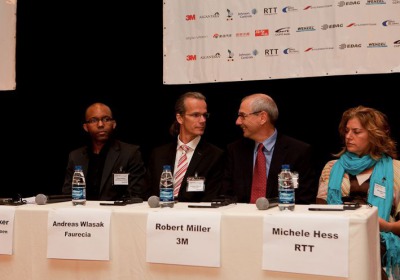Interior Motives China Conference 2010: Day 2
Fri, 23 Apr 2010Session 5: Color and Trim
On the second day of the conference, Andreas Wlasak, Vice President of Industrial Design at Faurecia, opened proceedings by announcing that the company plans to open a design studio in Shanghai this year. "A design centre in Shanghai – a new place in China for 2010 – this is a commitment," he declared.
Wlasak then asked what OEMs should look for in terms of visualizing the concept of ‘green' design inside the vehicle interior: "OEMs might look for 'visual' green – how can you make it visible that the vehicle is efficient and reducing CO2?" He believed real wood is one likely way of achieving this, as people want to feel natural surfaces, and he also envisaged translucent surfaces playing a key role in years to come.
Robert Miller, Advanced Global Lighting and Design Manager, Global Automotive, at 3M, said ambient lighting will be a major player in the future, with the use of LEDs becoming widespread in automotive interiors. "Some OEMs are using cool, neutral and warm LEDs instead of colors to define automotive interiors," he said. Typically there are two main brackets of interior lighting: functional, and ambient lighting. Precision lighting (PLE) is used to project light in a certain direction so as to serve a ‘function', while light strings (LS) are used to create a certain 'ambience'.
Michele Hess, Director of Materials Research at RTT, used the conference to highlight the global trend for textured surfaces that look handcrafted – what she calls the 'Trend of Artisanship'. During the question and answer session that followed, Hess was asked by a young Chinese designer how she identifies such trends. "Look for macro trends," she replied, using the fashion industry as an example. She added that it is important to look for trends as a group so that a single opinion is not confused with a trend.
Another topic that came up during the Q&A was the 'smell' of a new car. Designers were asked whether the new-car smell is safe, and whether this smell can be altered to suit tastes. Another probing question revolved around the use of ‘water' in the interiors of a vehicle. Robert Miller from 3M responded by saying that "a year ago an OEM had trim panels filled with water", and that the effect created by normal car movements was fascinating. RTT's Michele Hess revealed that she has also been asked to experiment with liquid, while Faurecia's Andreas Wlasak said that as vehicles move away from combustion engines, it's quite plausible that the fluids used in systems such as the HVAC may be made visible to passengers.
Session 6: Designs for China's Market Segments – Part One
During the Q&A, Walker was asked how involved PSA's Paris HQ was in the project. He replied that no management came over to see the car, though they had several digital design reviews. "Our director wanted to make sure the vehicle was completely 'Made in China'," said Walker, before adding that Metropolis is Citroën's response to the call for a truly Chinese-inspired car.
Walker concluded by stressing that China is too large and diverse for a singe C-factor to apply nationwide. "Here, the average age of a luxury car buyer is under 45 years old," said Walker, "This is a new market full of very open ideas."
Klaus Busse, Head of Interior Design and Component Commonization at Chrysler, was the next speaker. Since arriving at the company two years ago, he said he has done away with rigid, hard interiors and ushered in a premium feel.
He told the audience about a vehicle to be launched in June and destined to be sold in China: "Real wood, chrome appliances – all the goodies," he pledged. He also underlined the part to be played by the company's new ‘Uconnect' concave touchscreen, as previewed on the 200C concept of 2008. "The whole technology thing is a big deal for us," he added.
Gerardo Lourido of the EDAG Design Studio in Shanghai began his speech in fluent Chinese. He then switched into English, but by then his point had been made. An independent vehicle developer, EDAG unveiled an electric city car concept specifically for China at the 2010 Geneva motor show: the Light Car – Open Source. The car's body consists of smooth black panels that can display lighting at any point on the vehicle, and can be scaled for both large and small applications. "For creating future mobility you may need to jump out of your comfort zone," said Lourido, before adding that the days of electric cars needing big stickers to show that they are green are now over.
Continued →
By Namrita Chow

